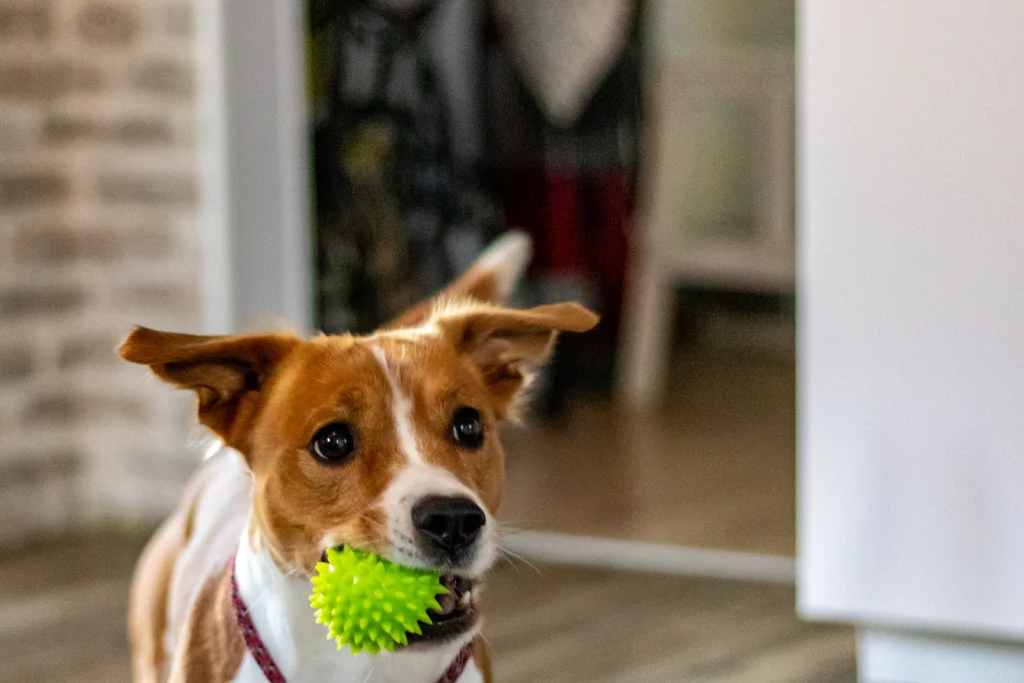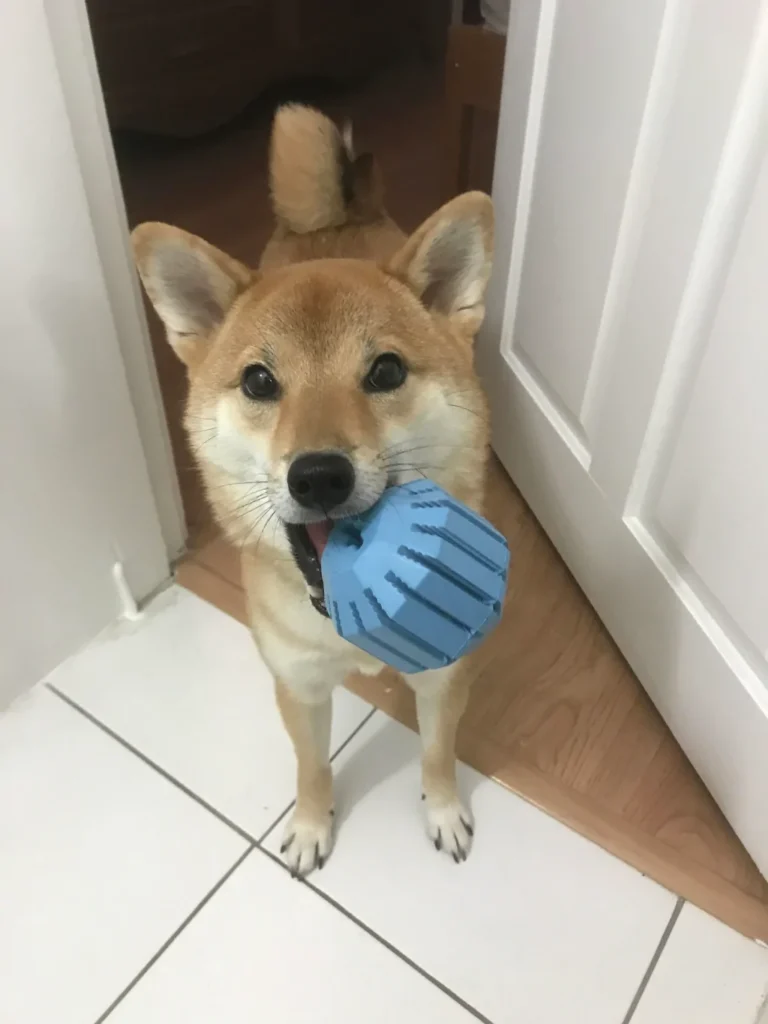Disclosure: We may earn a commission from helpful, relevant links in our content. No cost to you. See our privacy policy.
Ah, the joys of dog ownership – the wagging tails, the slobbery kisses, and the occasional stubborn streak when it comes to teaching new commands.
As a fellow pet owner, I know the frustration of trying to get your dog to release that oh-so-precious item from their jaws. Fear not, fellow dog lover!
With the right approach and a little patience, you’ll be able to teach your furry friend the “Give” command in no time – making playtime and everyday life safer and more enjoyable for both of you.
Ready to unleash your dog’s inner obedient pup? Let’s dive into the world of “Give”!

Why Is the “Give” Command Important?
The “Give” command is essential for several reasons. Firstly, it helps promote a safe environment for your pet.
Imagine your dog picks up something dangerous, like a chicken bone or a sharp object. Having them reliably respond to the “Give” command can prevent potential accidents and keep your canine companion out of harm’s way.
Secondly, teaching your dog the “Give” command can make playtime a breeze, ensuring smooth transitions between fetch, tug-of-war, and other activities.
In short, mastering this command is a game-changer for your dog’s safety, playtime, and overall obedience training.
Prepping for Training
Before diving into the nitty-gritty of teaching the “Give” command, let’s talk about setting the stage for success.
Start by choosing a quiet, distraction-free area for your training sessions. Dogs, like us, can become easily overwhelmed, so limiting distractions will help them focus on learning.
Next, gather some enticing treats or a favorite toy to use as a reward. Positive reinforcement is crucial when it comes to training, so having your pup’s go-to reward on hand is a must.
Lastly, remember to be patient and maintain a positive attitude – after all, you’re building a stronger bond with your furry friend, and that’s something to wag your tail about!
Step-By-Step Guide to Teaching “Give”
Step 1: Choose the Right Item
Select a low-value item that your dog enjoys but won’t fiercely guard. This can be a moderately interesting toy or a chew they like, but not ‘too much’.
Choosing the right item will make it easier for your dog to let go when commanded, and you can gradually introduce higher-value items as they become more proficient.
Step 2: Initiate Play
Start by engaging your dog in a playful activity with the chosen item. A gentle tug-of-war or fetch game is perfect for creating the opportunity to introduce the “Give” command.
Step 3: Introduce the “Give” Command
As your dog holds the item in their mouth, calmly say the command “Give” and present a treat or a higher-value toy near their nose.
Your dog will likely release the item to get the treat or toy. As soon as they let go, reward them with praise and a treat or toy.
Step 4: Reinforce the Behavior
Begin reinforcing the command after your dog has successfully responded to “Give” at least 5-10 times, and aim to practice the command for 10-15 minutes each day.
Repeat this process several times, ensuring you praise and reward your dog each time they release the item upon hearing the “Give” command.
Step 5: Gradually Increase Difficulty
Once your dog has mastered the “Give” command with low-value items, start introducing higher-value items. This can include their favorite toys or chews.
Your dog has mastered the command when they consistently release low-value items on the first “Give” command, without hesitation, for at least a week.
Always use positive reinforcement, and be patient as your dog adjusts to giving up more prized possessions.
Step 6: Practice in Different Scenarios
After your dog has mastered the “Give” command in a controlled environment, begin practicing in various settings with different distractions.
Introduce scenarios such as practicing in a park with other dogs playing nearby, or in a room with family members moving around to gradually increase the level of distractions your dog faces during training.
This will help your dog generalize the command, ensuring they’ll respond no matter the situation.
Remember, always maintain a positive and patient attitude throughout the training process. Your dog will pick up on your energy and be more inclined to learn if the experience is enjoyable for both of you.

Overcoming Common Hurdles
Remember, patience and consistency are vital when overcoming these common hurdles. Keep a positive attitude, and don’t hesitate to seek professional help if you’re struggling with a particular issue.
Keep It Up: Reinforce the “Give” Command
I remember when I was training my dog, Sam, to “Give”. We would practice during our daily games of fetch. Whenever Sam brought back the ball, I would say “Give” and reward him with a treat or praise when he dropped the ball. Over time, Sam became a pro at giving the ball back, making our playtime more enjoyable and stress-free.
So I learned that to ensure long-lasting success with the “Give” command, it’s essential to continue practicing and reinforcing the behavior regularly.
Try to incorporate the command into your dog’s daily routine, like during playtime or when they’re interacting with various items.
Remember, consistency is critical, so make sure you’re using the same command and rewarding your dog each time they successfully “Give”. A similar guide to teach “drop it” command is also available, so check it out.
To see this in action, here’s Ken Steepe from McCann Dog Training on teaching your dog to Drop or Give a ball:
FAQs
When should I start teaching my dog the “Give” command?
Begin teaching your dog the “Give” command as soon as they’re comfortable with basic obedience commands like “Sit” and “Stay”. Starting early helps establish a strong foundation for more advanced training.
How long does it take for a dog to learn the “Give” command?
Generally, with consistent training, most dogs can learn the command within a few weeks. However, the time it takes for a dog to learn the “Give” command varies depending on factors such as age, breed, and previous training experience.
Can I use the “Give” command for multiple items?
Absolutely! The “Give” command is versatile and can be used for various items, from toys to chews. Once your dog masters the command, they should be able to “Give” any item you ask them to release.
Is the “Give” command suitable for all dog breeds?
Yes, the “Give” command is suitable for all dog breeds. It’s a valuable command that helps promote a safe environment and better communication between you and your dog, regardless of their breed or size.
Alex, a passionate animal lover, has experience in training and understanding animal behavior. As a proud pet parent to two dogs and three cats, he founded AnimalReport.net to share insights from animal experts and expand his knowledge of the animal kingdom.





Nice post. It’s very well thought out and quite educating. Stick with it.